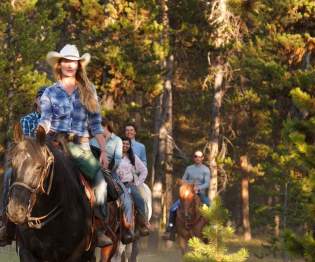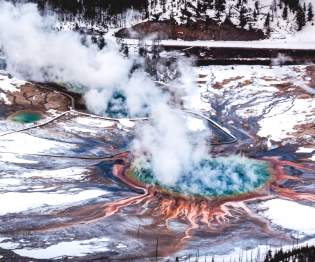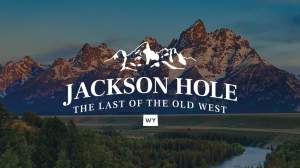Yellowstone National Park
Known as the Serengeti of North America, Yellowstone National Park encompasses more than 2 million acres of pristine land and is home to more than 100 species of wildlife, including wolves, elk, deer and bison. Founded in 1872 with the aim of preserving the land’s timeless majesty for future generations, Yellowstone is the world’s first and oldest national park and the centerpiece of the Greater Yellowstone Ecosystem, one of the largest intact temperate-zone ecosystems remaining on Earth. With abundant wildlife, varied terrain, and world-famous geothermal features, Yellowstone National Park is a destination for adventure.
Visitors looking to experience Yellowstone with a touch of Old West charm can explore the park on horseback or by wagon. Horse rides depart from Canyon, Mammoth, and Roosevelt Corrals, and stagecoach rides from Roosevelt Lodge. Once the sun sets, visitors may finish the day with an authentic Old West cookout dinner.
Yellowstone National Park also offers exciting experiences for the park’s youngest visitors. Located near Old Faithful, the Old Faithful Visitor Education Center features a kids' room and working model geyser, as well as science, history, and art activities in the National Park Service Junior Ranger program. Students receive an official Junior Ranger badge for completing the program.
Seasonal Weather in Yellowstone
Spring (late April–June)
The warming weather of spring brings transition to Yellowstone as valley lakes thaw in late May, snow levels fall in mid-June, and valley wildflowers peak in June and July. Rain and occasional snow are not uncommon though days are often mild and nights cold. Many locals consider spring the ideal time to visit Yellowstone for the many events and activities on offer in Jackson Hole. Explore our itineraries for every type of visitor including The Adventurer, The Foodie, and The Family.
Summer (July-August)
Summer days are warm, and nights are cool in Yellowstone. Afternoon thundershowers are common while ground snow levels gradually retreat into August, leaving many canyon areas free of snow by the end of the month. During summer, wildlife and wildflowers are abundant in the park. With weather as variable as the terrain itself, visitors should arrive well-prepared and can consult our Pack Like an Expert for Your Summer Visit checklist. For Labor Day weekend visitors, we offer Your Guide to Labor Day Weekend in Jackson Hole.
Fall (September–November)
The change in season from summer to fall brings a change in color to the aspen and cottonwood trees of Yellowstone. Sunny days and cold nights are common, as are rainy and snow conditions. By late fall, elk in the park move to wintering areas in lower elevations as snow is persistent. Fall visitors can experience art, history, fashion, food, drink and more at Jackson Hole Fall Arts Festival, widely considered one of the premier cultural events of the Rocky Mountain West.
Winter (late November–April)
Winter visitors will witness the stunning beauty of the valley and mountains blanketed in snow with accumulations up to 5 feet in the valley and 10 feet in mountain areas. Days are sunny but cold and nights colder. Winter visitors who brave the weather will find perfect conditions for downhill and cross-country skiing, as well as snowshoeing, winter photography, and wildlife viewing. For other activities, Happy Active Family has shared helpful tips on Six Ways to Spend the Weekend Outside this Winter that are not downhill skiing.
To experience the park’s grandeur overnight, visitors can explore camping in Yellowstone and convenient lodging inside Yellowstone National Park.
Make the most of your spring season visit to Jackson Hole and Yellowstone National Park with our recommended itineraries.
Ready to join the Chamber? Need more information? Explore our Explorer Magazine Travel Planner, which you can also explore electronically HERE. If you're already here, feel free to stop by one of our Visitor Centers where an experienced agent will be able to guide you in the right direction.





